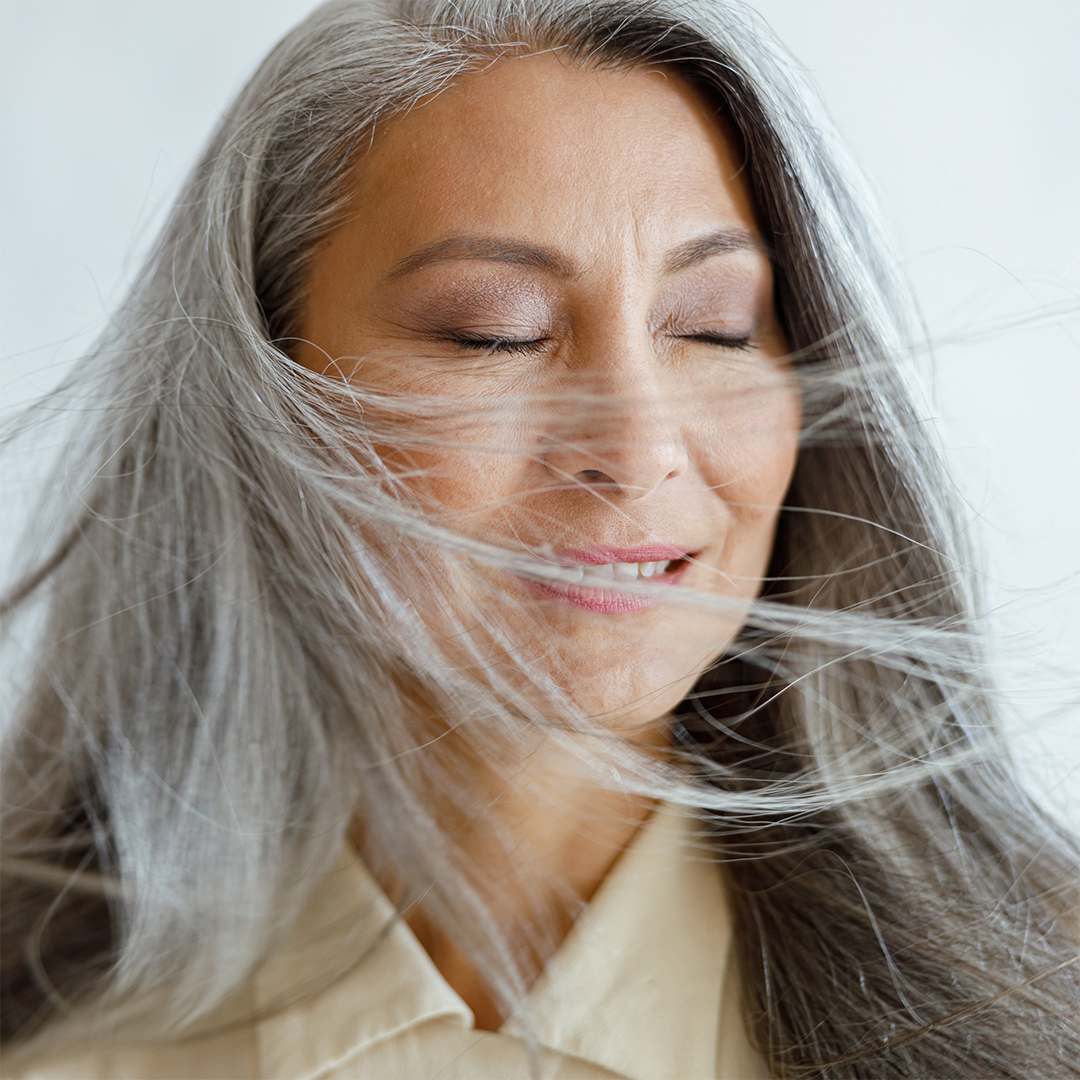

INTRODUCTION
About graying hair
Hair is not just a part of our body. Its length, color, shine, and appearance all affect how we are perceived by others, for better or worse. Hair color reflects our individual identity and is associated with social norms, fashion, and trends.
Hair graying is inevitable, it develops with age and is a universal problem not related to gender. However, for almost everyone it is seen as a tangible sign of aging and one that can seriously affect self-esteem. Generally, people start graying between the ages of 25 and 35, depending on the population in question, but this can vary significantly. Premature graying (<20 years) is usually caused by comorbidities. However, it can be related to factors such as stress, diet, medications such as chloroquine and smoking (ZAYED et al. , 2013).
The term "grey hair" refers to a mixture of normally pigmented hair and hair with a lack of pigmentation or no pigmentation. The appearance of grey hair varies in intensity and frequency depending on the geographical area and therefore the ethnic origin of the population studied (PANHARD et al. , 2012). For example, among people aged 45–64, the intensity varies from 15% to 37% depending on the geographical area. Most white hair does not contain melanin. The amount of melanin produced by follicular melanocytes begins to decrease and eventually stops completely. Hair colouring treatments have been the most popular way to change hair colour for thousands of years, because spontaneous repigmentation is very rare (PANDHI et al. , 2013). They give quick results, but are not easy and are associated with the risk of irritation, allergies or even more serious problems. Hair colouring treatments are most popular among women in Western countries, but are also widely used by men in the East.
Another solution is to stimulate the synthesis of melanin by melanocytes in the hair and activate the key enzyme in melanogenesis, tyrosinase. This requires the stimulation of pigmentation pathways, in particular by enhancing certain factors such as MITF, TYRP1 and CREB, which are strongly involved in this process. It is also necessary to promote communication between the melanocytes of the hair follicles and the keratinocytes that produce hair, via dendrites, which facilitates the transfer of melanin from melanocytes to keratinocytes.
The graying process can also be limited by providing antioxidant protection to melanocytes. Intense melanocyte activity throughout the hair growth cycle (3 to 5 years) produces harmful reactive oxygen species (ROS) such as hydrogen peroxide. These radicals damage cells and affect pigment function. Catalase stimulation and reduced glutathione help control these radicals
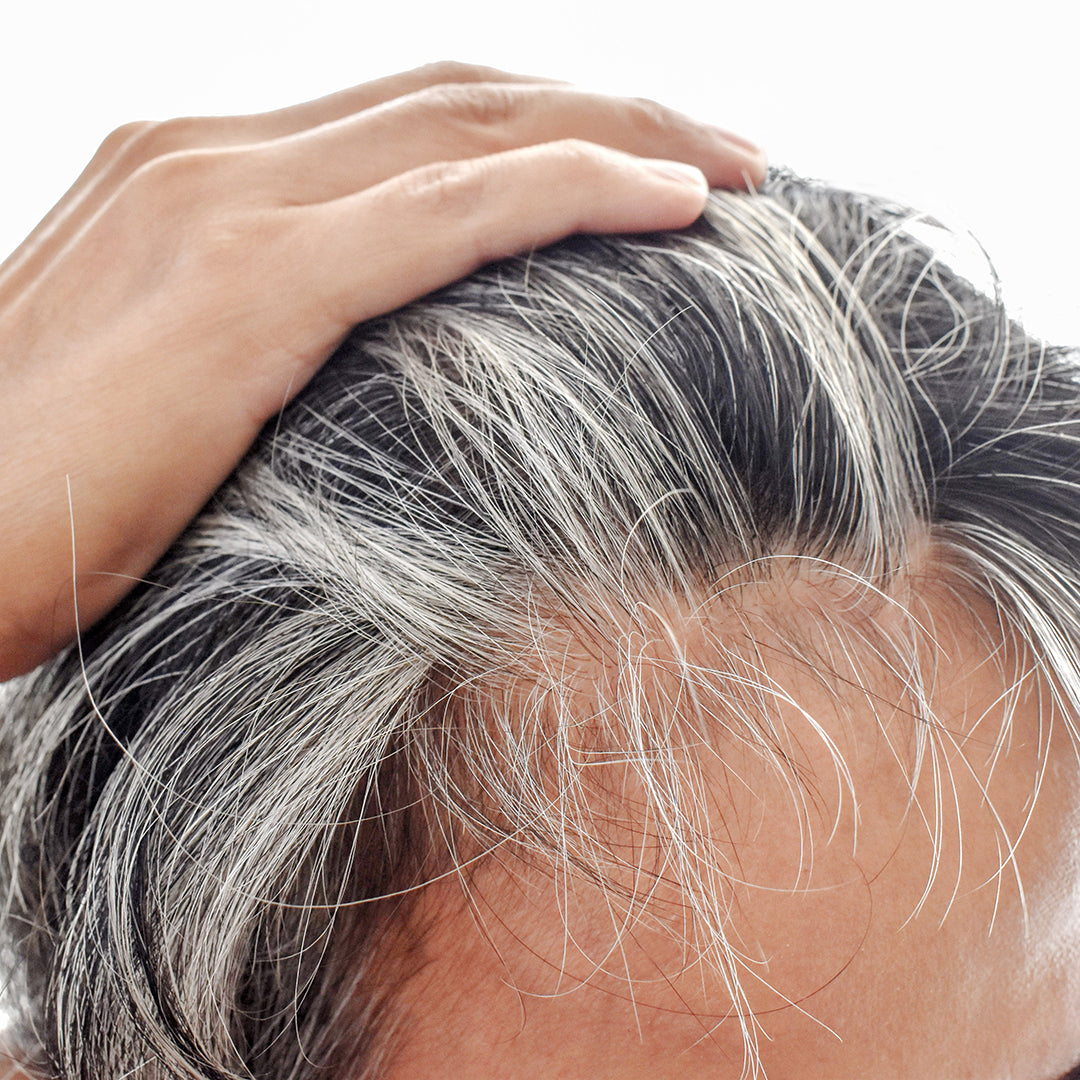

GENERAL CONTEXT
Hair Symbolism
Hair is an important part of our identity. Since the beginning of human history, for both men and women, the length, color, shine, and appearance of hair have influenced how we were and are perceived by others.
Hair has great significance in mythology. It captures our imagination as a tertiary sexual characteristic and can create attraction in others. In many cultures, such as Indian, Egyptian, Greek and Germanic, people had to keep their hair in good condition because it was a symbol of masculinity, strength, royalty or beauty. It was also an indicator of social status and hierarchy. Throughout the world, the way men and women styled and colored their hair, whether in Babylon, China, Egypt or ancient Rome, was closely linked to their social and civic position.
Hair color is one of the most striking features of a person. Hair can be black, brown, blond or red, with many shades in between. Although completely white hair is often associated with great wisdom, men and women have always sought ways to hide gray hair because of its aging effect.
A Brief History of Gray Hair Coloring Treatments
Natural hair color depends on two types of melanin, which also give color to the skin and eyes. These are eumelanin, which is brown or black, and pheomelanin, which is red or yellow. The ratio between these two pigments determines all possible shades of hair. However, with age, the hair loses its pigmentation, as do other organs. Already in ancient Egypt, people used scalp care and hair coloring treatments, which can be read about in the Ebers papyrus. For this, they used an ointment made of boiled blood taken from the base of the horns of a black bull. The famous pharaoh Ramesses II dyed his gray hair with henna, and others used indigo to obtain a black color. Pliny the Elder described that the Romans used henna, saffron or a marinade of leeches in red wine, depending on the desired shade. In the medieval work De Ornato Mulierum we find a recipe for a mysterious headless and tailless lizard that was supposed to be used to mask gray hair. The same recipe was also given by the famous Nostradamus in his treatise from 1550. Today, both artificial and natural hair dyes are available on the market, which have their advantages and disadvantages. Artificial hair dyes are permanent and often contain chemicals (hydrogen peroxide or hydrogen peroxide, ethanolamine, paraphenylenediamine, etc.) that can cause allergies. Natural hair dyes made from henna, indigo or katam last for a short time.
The Evolutionary Role of Hair and Melanin
About 90% of the world's population has black hair, which is very rich in eumelanin. Only a small fraction of people have more diverse hair colors, a feature that appeared late during migration to cold regions of Europe. Three features, the unusual length of the hair, as well as its thickness and richness of melanin, have been preserved by evolution due to their selective advantages for humans. These three features make humans unique among primates. Evolutionary researchers argue that the melanin in the hair of our distant ancestors helped them survive better in their environment, which was paradoxically naturally polluted with heavy metals.

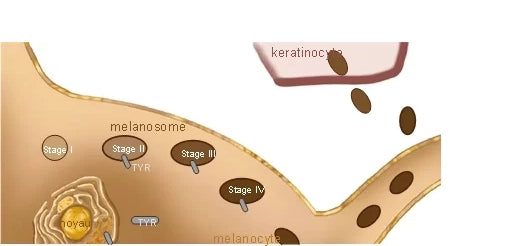
Eumelanin has a high affinity for metals and toxins, which enables it to efficiently remove toxins from our blood, originating from food or the environment, using little energy. These products, thus harmless, are stored outside the body in the inert structure of the hair.
Having darker hair was therefore an ingenious and safe way to increase the body's cleansing capacity. Each of our 90,000 to 130,000 hair follicles has its own vascular network, in the dermal capillary, which also acts as an exchange surface with the body. In addition, humans have a large amount of body hair, eyelashes and eyebrows.
The fact that the presence of drugs and doping agents can be detected in athletes' hair demonstrates this little-known property.
Another property of eumelanin is its ability to modulate the balance of calcium, an ion essential for cell homeostasis and, more specifically, for the maturity of keratinocytes, cells that play an important role in hair growth.
Calcium also participates in pigmentation and melanosome transport (Fig. 1).
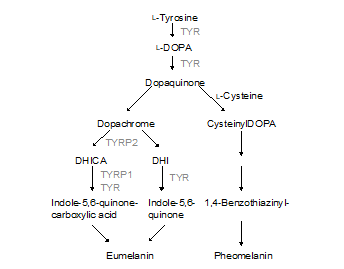

In addition, eumelanin is a detoxifier of cytotoxic free radicals. In particular, it neutralizes the superoxide anion (O2°-), which is generated by oxidative stress related to pollution or sun exposure. In contrast, O2°- is needed for melanin production, so that the enzyme tyrosinase can convert L-tyrosine into dopaquinone (Fig. 2). In this way, the cell finds a useful polymer to control this anion (WOOD et al., 1999). Eumelanin, due to its high concentration in hair, blocks the harmful effects of UV and infrared radiation on the hair fiber. The loss of hair pigmentation due to ageing causes hair to weaken, and permanent dyes and coloring agents then have less adhesion, a phenomenon well known to hairdressers (WOOD et al., 1999).
Frequency and intensity of grey hair
Gray hair is hair that has a partially natural, dark and strong color mixed with hair of weaker pigmentation and hair that appears completely white. The older we are, the less hair we have from the first group and more from the second and third. White hair is actually very light yellow because of the keratin it contains (PANDHI et al., 2013). It looks white because it reflects the light that falls on it.
Greying of hair due to age is a universal problem that is common among both men and women.
Cases of very premature greying are often associated with autoimmune diseases, including vitiligo and a rare disorder known as Werner's syndrome. They may also be associated with vitamin deficiencies or the use of drugs such as chloroquine (DI GIACOMO et al., 2009). Some nonpathological cases have also been reported.
The average age of graying in the Caucasian population is 34±9.6 years, and in the African population 43.9±10.3 years. There are also differences between the major ethnic groups when it comes to premature graying. Natural graying is considered premature in Caucasian adults if it occurs before the age of 20, before the age of 25 in Asian populations, and before the age of 30 in African populations (ANGGRAINI et al., 2019; KUMAR et al., 2018; TOBIN et al., 2001).
Our hair goes through a graying phase before it becomes completely white. White hair does not contain melanin because it is no longer produced by the melanocytes of the hair follicles.
The percentage of white hair increases gradually with age. The 50-50-50 rule states that 50% of people over 50 years of age have at least 50% grey hair (JO. et al., 2018). Many authors have published different values for the percentage of grey hair. This is because there is no standardized scoring method (SINGAL et al., 2016). The 50-50-50 rule was contradicted by a study that showed a different percentage for the population (PANHARD et al., 2012).
This study, which involved 4,192 male and female volunteers, showed that by the age of 45, 57% of people have gray hair, with an average intensity of 15%. By the age of 50, 6-23% of the world's population has 50% gray hair. By the age of 60, 91% of the world's population has gray hair, with an average intensity of 40%.


Table 1 shows the prevalence and intensity of gray hair by geographic area at comparable ages. It should be noted that sub-Saharan and African-American populations have the lowest prevalence of gray hair of all populations studied. In contrast, North Africans (87%), Mexicans (89%), Caucasians (85%), Russians (84%), Poles (82%), French (93%), and Lebanese (91%) are among the groups with the highest prevalence. Asian populations are at both ends of the spectrum, with the Japanese having the lowest prevalence, while Koreans and Chinese have the highest. Indians are ranked at a similar level to European populations.
In men, hair tends to go grey around the temples more often, followed by the top of the head. In women, the temples and top of the head tend to go grey at the same time and with the same intensity.
Graying hair almost always has a negative impact on self-confidence and often affects relationships with others. The usual solution for women is to dye their hair, but this is much less popular among men.
We will provide a brief overview of the hair growth cycle before discussing pigmentation modulation, as these two phenomena are very closely related.
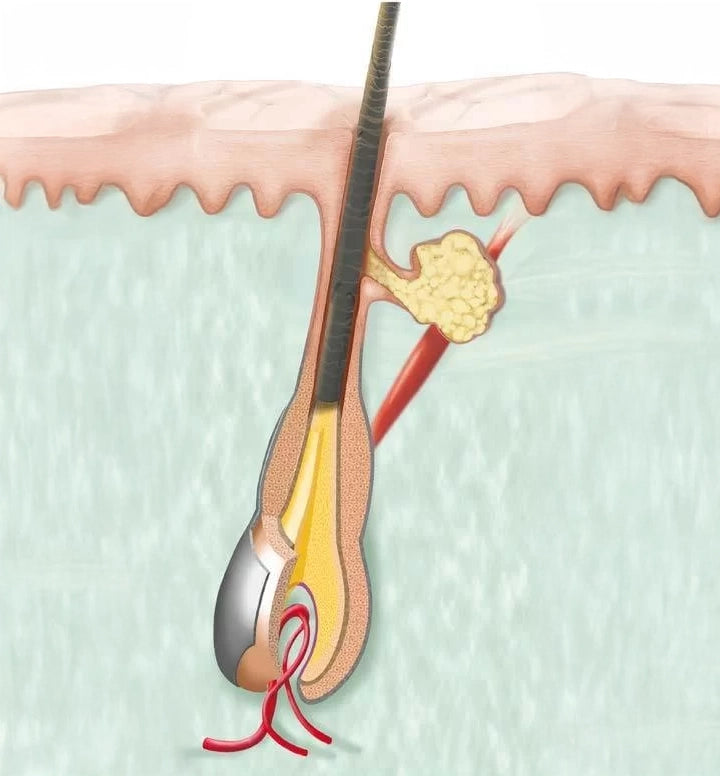

Hair growth
Hair (Fig. 3) is one of the most proliferative organs of the body. It grows about 1 cm per month. Unlike in mice, the growth of each human hair is independent of the others. The life and death of hair is a drama that takes place in three acts: ACT
Active hair growth and the melanization process by melanocytes in the hair bulb occur only during the hair growth phase, known as the anagen (A) phase. On average, this phase lasts from 2 to 5 years, but in extreme cases it can last up to 10 years (TOBIN, 2008). 85-90% of hairs are normally in the anagen phase.
Before this phase, the hair root sheath is empty (Fig. 3). The base of the old hair is formed by a structure known as the papilla, which is rich in fibroblast-like cells. The papilla is in contact with a bulbous part of the sheath called the bulge, where the hair stem cells (which are melanocytic and keratinocytic) are located. The proximity of the dermal layer and these stem cells causes a profound change in the synthesis of these normally non-proliferative cells and causes the new follicle to enter the anagen phase.
In terms of hair fiber growth, a new set of hair papilla progenitor cells and keratinocytes form a highly proliferative structure that extends the sheath and moves it away from the bulge (Fig. 3-(2)). During this phase, several cell types emerge, the outer root sheath cells (Fig. 3), the inner root sheath cells, and related cells that play a role in their maturation (MESLER et al. , 2017). The structure then enlarges to encompass the hair papilla. The new hair enters the dermis and reaches its final position deep in the skin. At this point, fiber production begins with the intensive production of keratins and keratinocytes, which then form the outer hair cuticles and cortex.
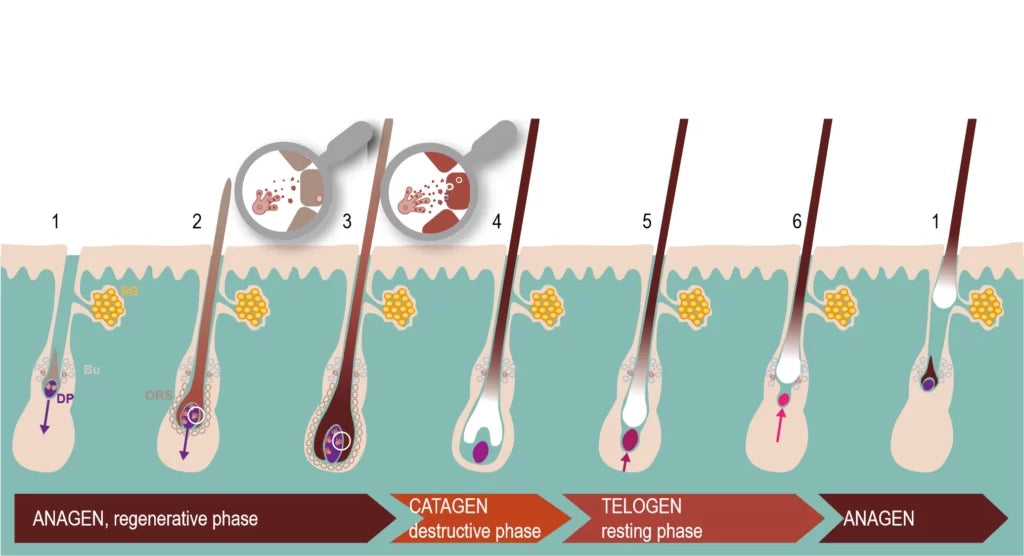
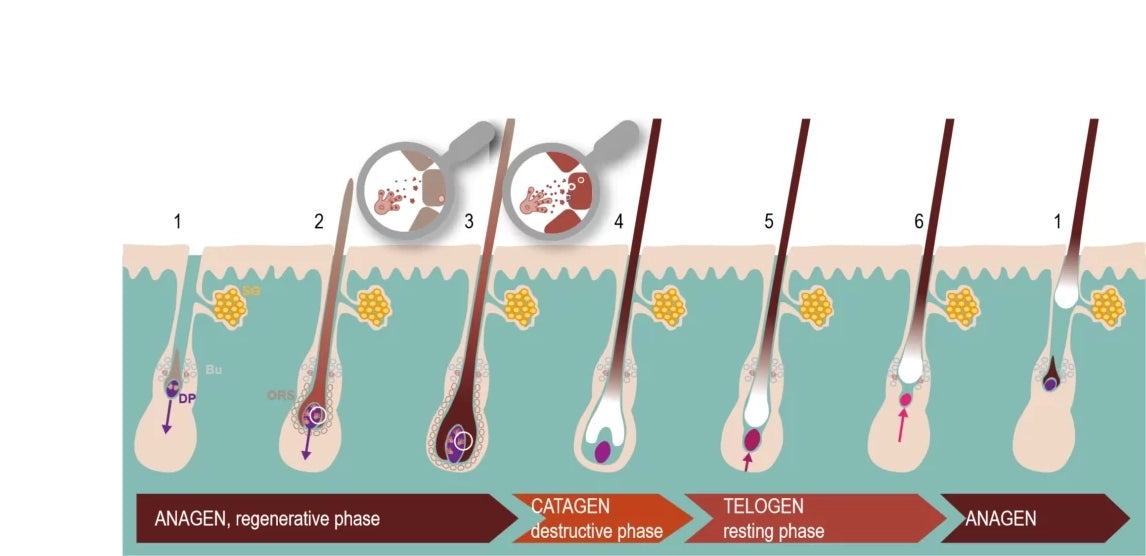
At the end of the anagen phase, the follicle enters a regression phase called the catagen phase (C) and synthesis ceases. The fiber no longer grows (Fig. 3-(3)). This phase lasts only a few weeks and affects about 2 to 3% of all hairs. The keratinocyte cells and melanocytes gradually disappear. The bulb collapses but retains the hair papilla.
The papilla then begins to move towards the bulge, this is known as the telogen (T) phase, which precedes the new anagen phase. 8 to 10% of the entire head of hair is in the telogen phase. The hair remains in this phase for about 6 to 7 months in young people, but longer with age (TOBIN et al. , 2001).
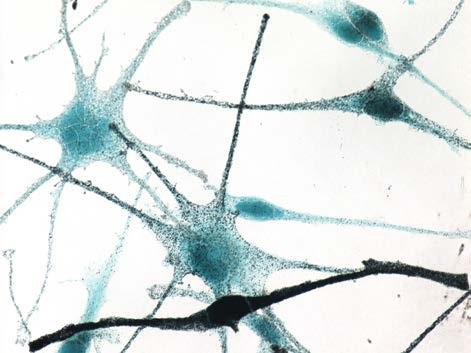
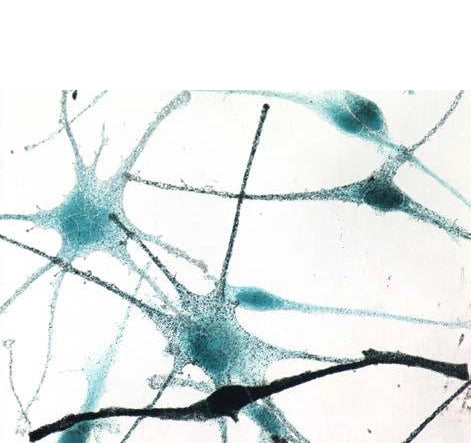
Hair melanization
Melanin is produced in the same way, whether in the epidermis or in the hair follicles. In all cases, L-tyrosine is the initial substrate for the enzyme tyrosinase (TYR, Fig. 2), whose activity produces dopaquinone. This molecule is the starting point for two types of melanin: pheomelanin and eumelanin (Fig. 2). Tyrosinase activity is one of the preferred targets of products on the market that reduce pigmentation, such as arbutin, which competes with tyrosine at the same site and therefore inhibits melanin production. Conversely, an increase in its overall activity promotes better pigmentation due to the resulting increase in melanin production (TOBIN, 2008).
Eumelanin is synthesized after several transformations caused by the action of other enzymes such as TYRP1 and TYRP2 (Fig. 5). Pheomelanin follows a different route and uses the sulfur amino acid L-cysteine.
This synthesis decreases and then stops completely at the end of the hair growth phase. Tyrosinase activity can no longer be detected. Melanocytes do not survive the catagen phase (TOBIN, 2008).
With age, gray and white hair (including beard hair) appear to grow faster than hair that is still pigmented. This indicates that melanin plays an inhibitory role in the proliferation of fibrillar keratinocytes (NAGL and ARCK cited in TOBIN, 2008; FERNANDEZ-FLORES et al., 2019). Controversially, JO (2018) suggests that one way to moderate graying of hair would be to reduce the rate at which an individual's hair grows.
Causes of graying hair
The greying of hair is closely linked to aging. This process becomes very visible very quickly, unlike the aging process of other organs. The actual causes of greying are still a matter of debate due to the difficulties associated with studying this complex organ. It has often been suggested that a genetic component plays an important role, but with additional factors influencing the speed and intensity with which it appears. Moreover, and this is a little-known fact, although the production of melanin is very beneficial in protecting our skin from the sun, it is not without risks and consequences for the cell that produces it (TOBIN, 2008).
SAXENA et al., 2020 showed that premature graying was accompanied by an increase in lipid oxidation byproducts in the blood and a decrease in reduced glutathione (rGSH), a powerful natural antioxidant.
Pollution, stress, diet, smoking, obesity, and microinflammatory stress are likely factors that accelerate premature onset of graying (FERNANDEZ-FLORES et al., 2019; ZAYED et al., 2013). This additional stress also damages keratinocytes located near melanocytes and the production of soluble factors involved in melanogenesis. On the other hand, sunlight does not seem to activate the graying process either in terms of time (premature onset) or intensity.
There is some agreement that graying hair is associated with a strong decrease in active melanocytes, to varying degrees, in the gray hair bulb due to the effects of aging and oxidative stress. This leads to a lower rate of melanin and melanosome production, as well as a decrease in dendrite size and a decrease in dendrite-to-keratinocyte transfer. There is also reduced tyrosinase activity, and melanocytes show increased cytoplasmic vacuolization, indicating oxidative stress. In white hair, there are no more melanocytes in the bulb. They are unable to migrate during a new cycle (FERNANDEZ-FLORES et al., 2019).


Ethne and Sederma and the concept of fighting gray hair
Ethne Serum contains SILVERFREE™ , a cosmetic active ingredient developed by SEDERMA using the technology of "perfectly characterized peptides". SEDERMA is a world expert in this technology.
This peptide was found after testing dozens of peptide sequences on normal human melanocytes. It complements the wide range of peptides that SEDERMA already supplies to the global cosmetic industry with actions targeted at the dermal and epidermal layers of the skin (e.g. peptides from the Matrixyl® and Crystalide® families). SILVERFREE™ acts on another compartment of the skin: the hair follicle. This peptide stimulates melanin synthesis in melanocytes, the cells responsible for hair color. SILVERFREE™ stimulates the defense mechanisms of melanocytes against oxidative stress and the resulting cell damage. It also supports the transfer of melanin to keratinocytes, the cells of origin of the hair fiber.
SILVERFREE™ actively and significantly reduces grey hair, providing long-lasting results.
BIBLIOGRAPHY
Anggraini DR , Feriyawati L., Hidayat H. and Wanhyuni AS (2019) “Risk factors associated with premature hair graying of young adults.” Open Access Maced. J.Med. Sci. , 7 , 3762-3764.
Di Giacomo TB , Valente NYS and Nico MMS (2009) “Chloroquine – induced hair depigmentation”. Lupus, 18 , 264-266.
Fernandez-Flores A. , Saed-Lima M. and Cassarino DS (2019) “Histopathology of aging of the hair follicle.” J. Cutan. Pathol. , 46 , 508-519.
Jo S. K. , Lee Y., Kim C. D., Lee J. H. and Lee YH (2018) “Three streams for the mechanism of hair graying.” Ann. Dermatol. , 30 , 397-401.
Kauser S. , Westgate G., Green M. and Tobin DJ (2007) “Age-associated down regulation of catalase in human scalp hair follicle melanocytes.” Pigment Cell Res. , 20 , 432.
Kumar AB , Shamim H. and Nagaraju U. (2018) “Premature graying of hair: review with updates.” Int. J. Trichology , 10 , 198-203.
Lien W.-H. (2020) Signaling cross-talk in skin stem cells, Duve Institute , Bruxelles.
Mesler AL , Veniaminova NA, Lull MV and Wong SY (2017) “Hair follicle differentiation is orchestrated by distinct early and late matrix progenitors.” Cell Rep., 19 , 809-821.
Pandhi D. and Khanna D. (2013) “Premature graying of hair.” Indian J. Dermatol. Vener. Leprol. , 79 , 641-653.
Panhard S. , Lozano I. and Loussouarn G. (2012) “Greying of the human hair: a worldwide survey, revisiting the '50' rule of thumb.” Br. J. Dermatol. , 167 , 865-873.
Pillaiyar T. , Manickam M. and Jung S.H. (2017) “Recent development of signaling pathways inhibitors of melanogenesis.” Cell. Signal. , 40 , 99-115.
Saxena S. , Gautam RK, Gupta A. and Chitkara A. (2020) “Evaluation of systemic oxidative stress in patients with premature lesions and correlation of severity of hair graying with the degree of redox imbalance.” Int. J. Trichology , 12 , 16-23.
Singal A. , Daulatabad D. and Grover C. (2016) “Graying severity score: a useful tool for evaluation of premature canities.” Indium. Dermatol. Online , 7 , 164-167.
Slominski A. , Wortsman J., Plonka PM, Schallreuter KU, Paus R. and Tobin DJ (2005) “Hair follicle pigmentation.” J. Invest. Dermatol. , 124 , 13-21.
Tobin DJ and Paus R. (2001) “Graying: Gerontobiology of the hair follicle pigmentary unit.” Exp. Gerontol. , 36 , 29-54.g
Tobin DJ (2008) “Human hair pigmentation – biological aspects.” Int. J. Cosmet. Sci. , 30 , 233-257.
Wiriyasermkul P. , Moriyama S. and Nagamori S. (2020) “Membrane transport proteins in melanosomes: regulation of ions for pigmentation.” BBBA Biomembr. , In Press.
Wood J.M. , Jimbow K., Boissy RE, Slominski A. Plonka P.M., Slawinski J., Wortsman J. and Tosk J. (1999) “What's the use of generating melanin?” Exp. Dermatol. , 8 , 153-164.
Xiao L. , Zhang R. Z. and Zhu W. Y. (2019) “The distribution of melanocytes and the degradation of melanosomes in fetal hair follicles.” Micron , 119 , 109-116.
Zayed AA , Shahait AD, Ayoub MN and Yousef AM. (2013) “Smokers' hair: does smoking cause premature hair graying.” Indium. Derm. Online J. , 4 , 90-92..